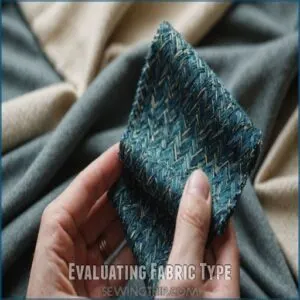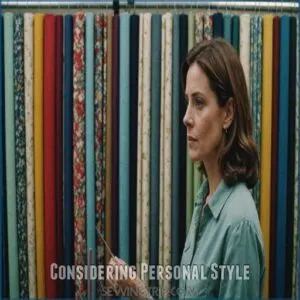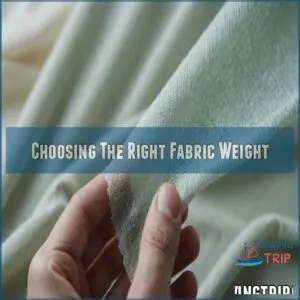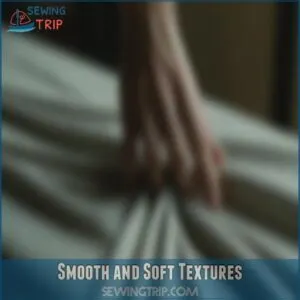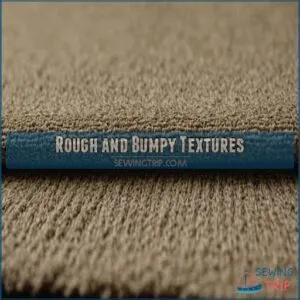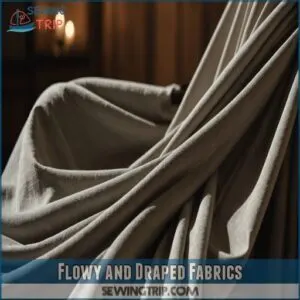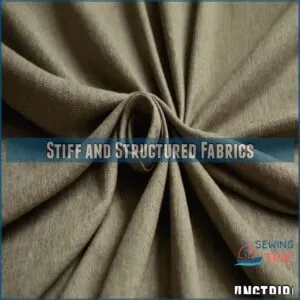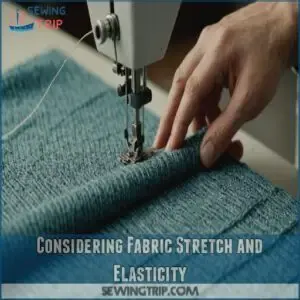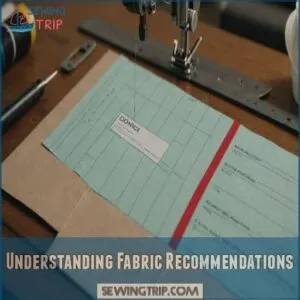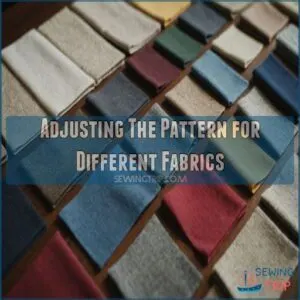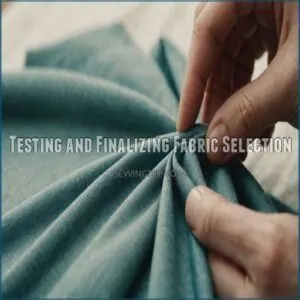This site is supported by our readers. We may earn a commission, at no cost to you, if you purchase through links.
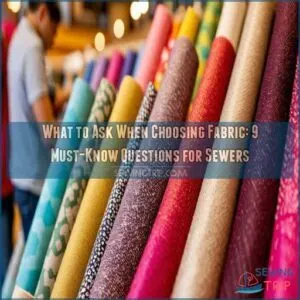
Start by asking about the fabric’s drapability, since nobody wants a stiff tutu when they’re aiming for a flowy gown.
Consider the stretchiness; will those pants give you space to breathe or hug you tighter than your favorite jeans?
Also, pay attention to fiber content: natural, synthetic, or blended? Each has its charm!
Don’t forget your project’s specific needs—will this fabric match your lifestyle and care routine?
Ponder these questions before cutting that fabric! Curious about more tips? Stay tuned!
Table Of Contents
- Key Takeaways
- Evaluating Fabric Type
- Considering Personal Style
- Assessing Garment Requirements
- Choosing The Right Fabric Weight
- Selecting Fabric Texture and Drape
- Considering Fabric Stretch and Elasticity
- Budgeting for Fabric
- Following Pattern Guidelines
- Testing and Finalizing Fabric Selection
- Frequently Asked Questions (FAQs)
- Conclusion
Key Takeaways
- Consider the fabric’s drapability and stretchiness to ensure it aligns with your project needs and desired garment flow.
- Pay attention to fiber content—natural, synthetic, or blended—each offering unique benefits, so match them to your preferences and project goals.
- Think about the practical aspects such as care requirements and how the fabric fits into your lifestyle for ease of maintenance.
- Always check the pattern’s fabric recommendations and be ready to test with a small sample to avoid surprises later.
Evaluating Fabric Type
You’re about to start a fabric-filled adventure, so let’s unravel the mystery of fabric types together!
From cozy cotton to slippery silk, understanding the different fibers and their quirks will help you pick the perfect material for your next sewing masterpiece.
Natural Fibers
When choosing fabric, natural fibers should be at the top of your list. They’re nature’s gift to sewers, offering a world of possibilities.
Natural fibers include:
- Cotton’s soft embrace against your skin
- Linen’s breezy coolness on a summer day
- Wool’s ability to retain heat well due to its crimped fibers that trap body heat effectively. Wool’s cozy warmth in a winter coat
- Silk’s luxurious drape in an evening gown
- Hemp’s eco-friendly durability for everyday wear.
Many natural fibers, such as breathable fabric options, breathe, feel great, and often improve with age.
Plus, they’re sustainable choices that’ll make Mother Nature smile. Who knew being eco-friendly could feel so good?
Synthetic Fibers
Synthetic fibers offer a whole new world of possibilities for your sewing projects.
Unlike their natural counterparts, these man-made marvels boast impressive durability and performance.
You can explore various synthetic fabric uses to find the perfect fit for your needs.
You’ll love how they maintain their shape, making them perfect for travel-friendly garments.
But here’s the kicker: they’re often more affordable and easier to care for.
Just remember, some synthetics mightn’t breathe as well as natural fabrics, so consider your comfort needs too.
Blended Fibers
Two fibers are better than one regarding blended fabrics.
When choosing fabric, consider sheer options like silk and polyester blends, which offer a range of benefits, including transparency, color variation, and textural interest, especially when working with types of sheer fabric. These clever combos give you the best of both worlds, mixing natural and synthetic fibers to create fabrics with superpowers.
Here’s what you need to know:
- Cotton-poly blends offer breathability and wrinkle resistance
- Wool-nylon mixes boost durability and reduce shrinkage
- Rayon-spandex blends provide comfort and stretch
- Silk-linen combinations balance luxury with structure
When choosing blends, consider the blending ratios and how they’ll affect your fabric’s properties and care instructions.
Specialty Fabrics
Beyond the everyday fabrics, there’s a whole world of specialty options to explore.
Ever heard of performance fabrics that wick away sweat? Or technical fabrics that resist wind and rain?
These fabrics are game-changers for specific projects.
Chenille, known for its signature soft, velvety texture, is an excellent choice for sewers looking for unique fabrics with a caterpillar-like appearance learn more about chenille’s manufacturing process. Don’t forget about novelty fabrics with unique textures or sustainable options made from recycled materials.
When choosing specialty fabrics, consider their unique properties and how they’ll enhance your project’s functionality and style.
Considering Personal Style
You’re not just sewing clothes; you’re crafting your unique style statement.
When choosing fabric, think about how it’ll fit into your wardrobe and express your personality – after all, you don’t want your handmade masterpiece to clash with your favorite shoes or end up hiding in the back of your closet!
Sustainable Energy Solutions
Hey, eco-warriors! Let’s talk about weaving sustainability into your fabric choices.
Just like picking energy-efficient light bulbs, selecting sustainable fabrics can shrink your carbon footprint.
Opt for organic cotton, hemp, or recycled polyester to show Mother Nature some love.
These fabrics aren’t just kind to the planet; they’re often softer on your skin too.
Plus, you’ll feel like a green superhero every time you slip on your handmade threads!
Smart Grid Technologies
When choosing fabric, think of it like designing your own smart grid.
Just as smart grids adapt to energy needs, your fabric choice should flex with your style.
Consider how different textures and patterns can modernize your wardrobe, making it more efficient and secure against fashion faux pas.
Analyze your current closet data and upgrade your style with fabrics that’ll keep you looking sharp and feeling confident.
Energy Storage Innovations
Considering your personal style isn’t just about fashion trends.
It’s about choosing fabrics that align with your values, like sustainability.
Think about energy-efficient fabrics that minimize waste in production.
Just as flow batteries store renewable energy, your fabric choices can store your commitment to eco-friendly living.
Look for innovations in recycled materials or low-impact dyes.
Your sewing project can be a statement of both style and environmental consciousness.
Assessing Garment Requirements
You’ve picked your style, now it’s time to match your fabric to your garment’s needs.
Think about when and where you’ll wear your creation.
How will it fit your body?
And, are you up for dry-cleaning battles or prefer tossing it in the wash?
Seasonal and Fashion Considerations
When selecting fabrics for your sewing projects, consider the unique demands placed on your garments, such as requiring moderate stretch fabric options. Four seasons bring unique fabric demands for your sewing projects.
Let’s match your fabric to the weather and current trends.
Here’s what to keep in mind:
- When selecting fabrics for warm weather sewing, consider cotton fabric weights to ensure your garments are both breathable and durable. Layer lightweight cotton voile for breezy summer dresses
- Pick cozy wool blends for fall statement pieces
- Choose water-resistant fabrics for spring rain gear
- Select breathable linens that work with current color trends
Don’t forget to check print directions – they’ll make or break your garment’s silhouette.
Occasion and Lifestyle
Before diving into your fabric selection, let’s match your lifestyle needs with the right materials.
When choosing fabrics, consider your comfort level with different fabric types and choose fabrics that align with the drapability, stretchiness, and stiffness required for the project, such as considering fabric texture.
Here’s a quick guide to help you nail the perfect fabric choice:
| Occasion | Best Fabrics | Care Level |
|---|---|---|
| Casual | Cotton, Jersey | Easy |
| Workwear | Wool, Linen | Moderate |
| Evening | Silk, Satin | High |
| Active | Performance Knits | Easy |
| Special | Brocade, Velvet | Professional |
You’ll want fabrics that can keep their shape and appeal while matching your daily hustle.
Body Type and Fit
Beyond special events, your garment’s success depends on how well it fits your unique body.
Pick fabrics that complement your shape – structured materials can create clean lines while drapey ones soften curves.
Pay attention to stretch and weight too – they’ll affect how the final piece moves and sits.
Remember, fabrics that make you feel confident will always be your best choice.
Care and Maintenance
While choosing fabric that matches your style is exciting, understanding care requirements helps your garments last longer.
You’ll want to check washing instructions and pre-wash fabric before cutting into it.
Here’s what to keep in mind:
- Will frequent washing fade or pill the fabric?
- Does it need special care like dry cleaning?
- Is it prone to shrinkage or color bleeding?
- Can you iron it without damaging the fibers?
Choosing The Right Fabric Weight
You’ll want to pick a fabric weight that’s just right for your project, much like choosing between a light summer breeze and a cozy winter blanket for your clothes.
Fabric weight is important for your project.
Whether you’re working with airy chiffons or sturdy denims, matching the fabric’s weight to your pattern will make the difference between a garment that flows beautifully and one that looks like it’s fighting against gravity.
Lightweight and Sheer Fabrics
Selecting lightweight and sheer fabrics opens up endless possibilities for your summer sewing projects.
You’ll want to think about fabrics like chiffon, organza, and lightweight cotton voile for their breezy drape and flow.
These delicate materials create stunning layered effects and add an ethereal quality to your garments.
Just remember to check the fabric’s transparency level – you might need to plan for linings or undergarments.
Medium-Weight Fabrics
Moving up from sheer fabrics, medium-weight options like cotton twill and linen offer that sweet spot of versatility you’ll love.
They’re not too flimsy, not too heavy – just right for everyday wear.
Think button-down shirts, skirts, and summer dresses.
These fabrics play nice with your sewing machine and hold their shape well, making them perfect for building your confidence as you sew.
Heavyweight Fabrics
Heavyweight fabrics give your projects that professional, high-end look you’ll love.
Perfect for coats and jackets, these fabrics hold their shape beautifully and keep you toasty warm.
Think wool melton, denim, and heavyweight twills – they’re your best friends for winter sewing.
Just remember to match your machine’s needle size and adjust your tension settings.
Your reward? Garments that’ll withstand years of wear.
Thick and Bulky Fabrics
When tackling thick and bulky fabrics, you’ll need the right tools and techniques to create stunning winter projects.
Working with these substantial materials can be challenging, but they’re perfect for structured garments.
- Choose a heavy-duty machine needle (size 90/14 or larger)
- Test fabric manipulation on scraps first
- Consider layering options carefully
- Use a walking foot for even feed
- Switch to polyester thread for strength
Selecting Fabric Texture and Drape
You’re about to become a texture detective, and your next case is cracking the code of fabric feel and flow.
Get ready to run your fingers over everything from silky-smooth charmeuse to nubby tweed as you learn to match textures and drapes to your sewing vision.
Smooth and Soft Textures
Smooth and soft textures can make or break your sewing project.
You’ll want to ask yourself, "How does this fabric feel against my skin?"
Run your fingers over it – is it silky, velvety, or buttery smooth?
These textures aren’t just about comfort; they affect how your garment drapes and moves.
A smooth fabric can give your outfit a polished look, while soft textures add a touch of luxury.
Rough and Bumpy Textures
Rough and bumpy textures add a whole new dimension to your sewing projects.
Ever run your hand over a nubby tweed or chunky bouclé? It’s like a mini-massage for your fingers!
These fabrics can bring depth and interest to your garments, but they’re not always a walk in the park to work with.
Consider how they’ll feel against your skin and if they suit your project’s vibe.
Flowy and Draped Fabrics
The allure of flowy and draped fabrics can’t be overstated.
They add a touch of elegance to your sewing projects, creating garments that move with grace.
When choosing these fabrics, consider:
- How they’ll drape on your body shape
- The weight’s impact on the overall look
- Care requirements (some delicate fabrics need extra TLC)
- Suitability for your sewing skill level
Remember, practice makes perfect when working with these dreamy materials.
You’ll be crafting ethereal masterpieces in no time!
Stiff and Structured Fabrics
When you’re aiming for garments with a bit of backbone, stiff and structured fabrics are your go-to.
These power players give your creations shape and substance.
Think crisp cotton shirts, fitted jackets, or that perfect A-line skirt.
They’re ideal for projects where you want to hold the line or create architectural details.
Just remember, working with these fabrics might require some extra muscle and specialized techniques.
Considering Fabric Stretch and Elasticity
You’ll want to get cozy with your fabric’s stretch factor before you start stitching.
Whether you’re dealing with clingy knits or sturdy wovens, understanding how your fabric moves (or doesn’t) can make the difference between a comfy masterpiece and a straight-jacket sensation.
Knits and Stretchy Fabrics
Stretchy knits are like the yoga pants of fabric – versatile and forgiving.
When working with these flexible friends, keep these points in mind:
- Stretch percentage: How much give does it have?
- Recovery: Will it snap back or stay stretched out?
- Weight: Light for tees, heavy for sweaters
- Stability: Some knits need interfacing for structure
Remember, sewing with knits is like dancing – once you get the rhythm, it’s a breeze!
Wovens and Stable Fabrics
Woven fabrics are your go-to for stability in sewing projects.
Unlike their stretchy cousins, these fabrics hold their shape well, making them perfect for structured garments.
You’ll find they come in various weights, from light cotton to heavy denim.
When working with wovens, consider the fabric’s drape and how it’ll affect your garment’s silhouette.
Don’t forget to check care instructions – some wovens can be finicky!
Stretchy and Elastic Fabrics
Elastic fabrics can be a sewer’s best friend or worst nightmare.
They offer comfort and flexibility but can be tricky to work with.
Understanding the different elastic fabric types can help you navigate this challenge, whether you’re working with spandex, elastane, or other stretchy materials.
Measure twice – stretchy fabrics can be deceptive!
Test your machine’s tension on scraps – avoid wavy lines.
Embrace the walking foot – it’s your best friend against puckering.
Remember, mastering stretch fabrics opens up a world of comfy, figure-hugging possibilities.
Don’t be afraid to experiment!
Non-Stretchy and Rigid Fabrics
While stretchy fabrics have their place, non-stretchy and rigid fabrics bring their own magic to your sewing projects.
Think crisp cotton shirts or structured jackets.
These fabrics hold their shape beautifully, perfect for sharp looks.
But remember, they can be less forgiving fit-wise.
When working with these fabrics, precise cutting and careful seam allowances are your best friends.
They’re ideal for projects where you want to showcase clean lines and defined silhouettes.
Budgeting for Fabric
You’ve picked the perfect pattern, but don’t let your budget unravel!
Let’s talk about smart fabric shopping that won’t leave your wallet in tatters while still snagging those dreamy materials for your next sewing masterpiece.
Setting a Budget
Setting a budget isn’t just about pinching pennies—it’s your ticket to guilt-free fabric splurges!
Before you hit the store, decide on your spending limit.
Compare fabric costs to ready-made garments and factor in your time investment.
Remember, quality often comes with a higher price tag, but it can be worth it.
Aim for a balance between your wallet’s comfort and your project’s needs.
Finding Affordable Fabrics
Everyone loves a good fabric bargain, and finding affordable materials doesn’t mean compromising on style.
Smart shopping can help you score great deals on beautiful fabrics for your projects.
- Check remnant bins at local fabric stores for discounted pieces
- Join Facebook marketplace groups to find fabric swaps and sales
- Visit thrift stores to repurpose garments for their fabric
- Browse online marketplaces during seasonal clearance events
- Sign up for fabric store newsletters to catch flash sales
Investing in Quality Fabrics
Beyond bargain hunting, quality fabrics can actually save you money.
Just like splurging on a great pair of shoes, investing in premium materials pays off.
Look for trusted retailers who source ethically and offer detailed fabric specs.
You’ll notice the difference in how these fabrics handle, press, and sew.
Plus, they’re less likely to pill, fade, or wear out quickly.
Considering The Cost-Per-Wear
Many sewists focus solely on upfront fabric costs, but calculating cost-per-wear helps you make smarter investments.
When you’re eyeing that pricier linen or wool, consider how often you’ll wear the finished piece.
A $30/yard wool coat worn daily offers better value than a $10/yard party dress worn once.
- Break down the total project cost (fabric + notions)
- Estimate yearly wear frequency
- Factor in fabric durability and care requirements
- Consider seasonal versatility
- Calculate cost divided by projected wears
Following Pattern Guidelines
You’ll find everything you need to know about fabric choices right on your pattern envelope, where it’s basically your trusty roadmap to sewing success.
Just like following a recipe saves you from kitchen disasters, sticking to these fabric guidelines will help you avoid those "what was I thinking" moments when your silky dress turns into an accidental potato sack.
Understanding Fabric Recommendations
While pattern envelopes might seem cryptic at first, they’re actually your fabric-choosing compass.
The fabric recommendations section tells you exactly what materials will make your project shine.
For projects requiring additional stability, you can find suitable interfacing pattern needs, such as interfacing pattern solutions, to make sure your project turns out as desired.
You’ll find details about weight, stretch requirements, and whether you need special interfacing.
Think of these suggestions as your sewing GPS – they’ll help you navigate straight to success.
Substituting Fabrics
When your dream fabric isn’t listed on the pattern envelope, don’t panic! You can often substitute fabrics with similar properties.
Consider these key factors before making the switch:
- Match the weight and drape of the recommended fabric
- Check if the original requires stretch properties
- Compare care instructions to make sure your substitute can handle similar washing
Remember, fabric stores often have great alternatives that’ll work just as well!
Adjusting The Pattern for Different Fabrics
Different fabrics behave uniquely, so you’ll need to adjust your pattern accordingly.
Think of it as giving your pattern a custom makeover for each fabric type.
Here’s a quick guide to common adjustments:
| Fabric Type | Pattern Changes | Special Notes |
|---|---|---|
| Stretchy | Reduce ease | Watch grain line |
| Sheer | Add seam allowance | Plan for layers |
| Heavy | Size up | Check drape impact |
Remember, your fabric’s personality will guide these tweaks – just like how you wouldn’t wear a winter coat to the beach!
Testing and Finalizing Fabric Selection
You wouldn’t buy a car without a test drive, and you shouldn’t start your sewing project without testing your fabric first.
Before you commit to yards of material, let’s explore how to put your chosen fabric through its paces to make sure it’s truly the perfect match for your project.
Purchasing a Small Sample
Smart sewists always start with a sample before committing to yards of fabric.
You can find various options for a fabric sample size to suit your needs.
You’ll want to grab a quarter yard or fat quarter to test how the fabric behaves.
This lets you check the drape, texture, and color in your home lighting.
Plus, it’s way better than kicking yourself later when those online fabric photos don’t match reality!
Sewing a Swatch or Sample Garment
Before diving into your sewing project, create a small test garment using your chosen fabric, especially when working with delicate or challenging sheer fabrics.
To master working with different fabrics, it’s essential to consider factors like fabric weight and stretch, as seen in double knit scuba tutorials. This lets you practice your sewing techniques and assess fabric handling.
Notice how easily it sews and how the drape looks.
Making a mini-version helps avoid costly mistakes later.
It’s like a test drive before buying a car!
Adjust your pattern or techniques as needed based on this trial run, ensuring a perfect fit and final product.
Evaluating Fabric Performance
Now that you’ve sewn a sample garment, it’s time to evaluate its performance.
Watch how the fabric drapes and flows, ensuring it doesn’t sag or stiffen unexpectedly.
Check for colorfastness by washing the sample—after all, nobody wants faded dreams!
Feel the texture against your skin and consider durability, because the perfect fabric should marry beauty with resilience.
Making Final Adjustments
When you’re figuring out the perfect fabric fit, you might need a few final tweaks.
Consider these steps:
- Check fabric drape for that flawless flow.
- Adjust the seam allowance to match your style.
- Use precise pressing techniques for professional results.
- Review your project timeline and double-check your sewing tools.
These tweaks will help your fabric choice fit like a glove!
Frequently Asked Questions (FAQs)
How to choose fabric for sewing clothes?
Did you know 90% of sewing success hinges on fabric choice?
Choose fabrics that suit your skill level.
Consider drape and texture, and don’t forget the project’s purpose.
Opt for colors that make your skin tone pop!
How do you choose a fabric for a sewing project?
Choose fabric by considering your project’s needs: check pattern recommendations, evaluate texture and drape, and match your skill level.
Balance budget concerns, care requirements, and personal style for a masterpiece that suits your vision perfectly.
What makes a good sewing project?
Over 60% of sewists enjoy making clothes.
A good sewing project matches your skill level, offers creative freedom, and results in something useful.
Choose projects that excite you; they’re more likely to keep you motivated and learning.
What questions should you ask when buying fabric?
Is the fabric suitable for your pattern and season?
Does it match your skill level?
What’s the care required?
Consider texture and drape, print direction, and budget.
How do I choose a fabric?
Fabric choice can feel like picking the perfect pasta sauce—too many options!
Examine the pattern’s fabric recommendations.
Consider your skill level.
Weigh the fabric’s texture, drape, and care needs to guarantee project success.
How do I start a sewing project?
Start your sewing project by picking a simple pattern, grabbing the essential tools—needles, thread, fabric scissors—and reading through the instructions.
Set up your machine, cut patterns carefully, and remember: practice makes perfect!
How to choose fabric for a sewing project?
Start by considering the sewing pattern and the project’s purpose.
Choose fabrics that suit your skill level and budget.
Think about fabric weight, texture, and care requirements.
Don’t shy away from asking for expert advice.
What are the 4 things to consider when choosing fabric?
Think of fabric like a canvas for your creativity: consider its pattern and color, how it drapes, texture and feel against your skin, and your sewing skill level to pick the perfect one for your project.
How would you know the amount of fabric to buy for a particular sewing project?
Check your pattern’s instructions! They’ll tell you exactly how much fabric you need. Don’t forget to add extra for mistakes—better safe than sorry!
How do I choose the right fabric for a pattern?
When choosing fabric for a pattern, ignore pattern suggestions at your peril.
Match fabric type and weight to design needs, consider your sewing skills, and don’t forget to imagine the finished garment swaying elegantly in your mind’s eye.
How does fabric color affect garment appearance?
Fabric color can transform a garment’s vibe, making it fun, sophisticated, or relaxed.
Dark colors slim, while light hues expand.
Bright shades highlight you in a crowd, leaving you feeling bold and confident in your personal style choice.
What are the fabrics care and maintenance requirements?
Imagine your fabric’s like a pet needing care.
Some are wash-and-wear kittens, others are dry clean-only hounds.
Always read labels carefully; consider how much effort you’re willing to give for maintenance before committing.
Is the fabric suitable for allergy-prone skin?
Choose natural fabrics like cotton or bamboo, known for being gentle on sensitive skin.
Avoid synthetic materials that might trigger allergies.
Always test a small patch on your skin to make sure it’s comfortable before sewing.
How will fabric shrinkage affect the project?
When fabric shrinks, it can lead to fitting issues, altering the final garment’s size and shape.
Pre-wash and dry your fabric to prevent unexpected surprises.
Always ensure your project fits just right after completion.
Can the fabric be easily altered or adjusted?
You know the saying, "The devil is in the details."
Fabrics like cotton and linen are easier to alter due to their forgiving nature.
While stretchy or delicate fabrics can be tricky, often requiring specialized techniques.
Conclusion
So, you’ve armed yourself with the knowledge to tackle those tricky fabric choices!
Remember, asking the right questions when choosing fabric for a sewing project is half the battle.
Think of it as a detective’s work – you’re gathering clues to find the perfect match.
What to ask when choosing fabric?
Consider drape, stretch, fiber content, and your lifestyle.
Don’t be afraid to test a sample before diving into your masterpiece.
Happy sewing!

